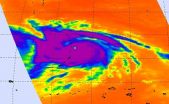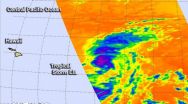(Press-News.org) Philadelphia, PA, July 9, 2015 - Researchers at Virginia Tech have developed a new scoring method for assessing beverage intake, the Healthy Beverage Index (HBI). In a report published in the Journal of the Academy of Nutrition and Dietetics they describe how this tool can be used to more accurately evaluate dietary consumption of all types of fluids. They found that higher HBI scores were associated with more favorable lipid profiles, decreased risk of hypertension; and, among men, better C-reactive protein (CRP) levels.
Water consumption is associated with numerous health benefits and beverage recommendations exist, but few have evaluated overall beverage intake quality. Beverage intake guidelines have been suggested and although the 2010 US Dietary Guidelines recommend "drinking water instead of sugary drinks," no tools existed that measure overall beverage intake quality.
"A Healthy Beverage Index (HBI), similar to the Healthy Eating Index, could be used to evaluate overall beverage intake quality and to determine if improvements in beverage intake patterns are associated with improvements in health," explained Kiyah J. Duffey, PhD, of the Department of Human Nutrition, Foods and Exercise, Virginia Tech University, Blacksburg VA. "A great deal of attention has been directed at sugar-sweetened beverage (SSB) intake, and a broader focus beyond just SSBs is needed."
Duffey and co-investigator Brenda M. Davy, PhD, developed the HBI, a 10-item scoring index that captures total energy from beverages, total fluid requirements, and recommended limits for beverage subgroups, such as low-fat milk, fruit juice, and alcohol. They weighted some components of the HBI more heavily because of their recognized contributions to good health, such as water contributing at least 20% of total fluid intake, and others less heavily, for example, consuming no more than 8 oz. of fruit juice.
Using dietary and health data from over 16,000 adults who participated in the nationally representative National Health and Nutrition Examination Surveys (2005-2010), Duffey and Davy calculated HBIs and correlated those with cardiometabolic risk factors such as obesity/overweight, hypertension, high fasting insulin, high fasting glucose, high low-density lipoprotein (LDL) cholesterol, and high CRP. The HBI score ranges from 0 to 100, with a higher score indicating better adherence to beverage guidelines and a healthier beverage intake pattern in both men and women.
The average HBI score was 63±16 out of 100 for the sampled population. Their analysis considered age, sex, race/ethnicity, level of education completed, marital status, household size, total daily energy intake, and physical activity as possible confounding factors.
Duffey and Davy found that people with better HBI scores had more favorable cardiometabolic outcomes. Among normal weight males, a 10-point higher HBI score was associated with an average 36% lower odds of having a high waist circumference and 7% lower odds of having high CRP levels. For overweight/obese males, each 10-point increment higher in HBI score was associated with 4% lower odds of having high fasting insulin and high LDL cholesterol levels and 3% lower odds of having high total cholesterol. The odds of having high CRP were also lower with each 10-point higher in HBI score in this group. Irrespective of weight status, each 10-point higher HBI score was associated with 4% lower odds of having hypertension.
Among all females, regardless of weight status, each 10-point higher HBI score was associated with an average 4% lower odds of having high fasting insulin levels, an average 3% lower odds of high LDL cholesterol, an average 5% lower odds of having low high-density lipoprotein cholesterol, and an average 3% lower odds of having hypertension.
For the "typical" person, there are three factors that lower the HBI score. SSB consumption of, for example, soda or a vanilla latte, deducted 15 points. More than 10% of daily energy requirements coming from beverages reduced the score by another 20 points. Finally, failure to meet total fluid requirements lost another 3 points for the typical person.
Davy emphasized that, "There is flexibility in the system, and there are some beverage categories that an individual could choose not to consume at all, for example, diet sodas or alcohol, yet they would still receive the maximum number of points for that category."
The authors would like this technique to be developed into a rapid assessment tool that might be used online to provide patients, doctors, and dietetics practitioners with accurate consumption information that could be used to encourage better eating behaviors. Also, they will continue to refine the index over time as new information about healthy beverage choices becomes available.
INFORMATION:
Natural environments are known to promote physical, mental, and spiritual healing. People can attain health benefits by spending time outside, often in remote places to "get away from it all." Now research conducted by a University of Minnesota graduate student with a team in Vancouver, B.C., shows that green and "blue" spaces (environments with running or still water) are especially beneficial for healthy aging in seniors.
Published in the journal Health and Place, the study -Therapeutic landscapes and wellbeing in later life: Impacts of blue and green spaces for older ...
Two of NASA's heliophysics missions can now claim planetary science on their list of scientific findings. A group of scientists used the Venus transit - a very rare event where a planet passes between Earth and the sun, appearing to us as a dark dot steadily making its way across the sun's bright face - to make measurements of how the Venusian atmosphere absorbs different kinds of light. This, in turn, gives scientists clues to exactly what elements are layered above Venus's surface. Gathering such information not only teaches us more about this planet so close to our own, ...
NASA's Aqua satellite passed over Supertyphoon Nangka on July 9 and provided a visible and an infrared view of the large storm.
At 0700 UTC (3 a.m. EDT) on July 9 a typhoon warning was in effect for Agrihan, Pagan and Alamagan in the northern Marianas. A tropical storm warning is in effect for Saipan and Tinian. Nangka passed over Alamagan.
The Atmospheric Infrared Sounder or AIRS instrument aboard NASA's Aqua satellite gathered infrared temperature data on Nangka on July 9 at 03:23 UTC (July 8 at 11:23 a.m. EDT). At the same time, the MODIS instrument took a visible ...
Studying the gastric cancers of 15 Southeast Asian patients, researchers at The Jackson Laboratory, the Genome Institute of Singapore and other institutions identified five recurrent fusion genes, one of which appears to lead to cellular changes involved in acute gastritis and cancer.
Worldwide, close to a million cases of gastric cancers are diagnosed each year, and some of the world's highest incidence rates are in Asia (particularly in Korea, Japan and China).
The researchers, led by JAX Professor Yijun Ruan, Ph.D., and Axel M. Hillmer, Ph.D., of GIS, published ...
LOS ANGELES (July 9, 2015) - After generating new brain tumor models, Cedars-Sinai scientists in the Board of Governors Regenerative Medicine Institute identified the role of a family of genes underlying tumor growth in a wide spectrum of high grade brain tumors.
"With these new genetic findings, our group of researchers plan to develop targeted therapeutics that we hope will one day be used treat patients with high grade brain tumors and increase their survival," said Joshua Breunig, PhD, a research scientist in the Brain Program at the Cedars-Sinai Board of Governors ...
Tropical Storm Ela was born in the western-most part of the Eastern Pacific Ocean but has become the Central Pacific's first named storm. NASA's Aqua satellite took a look at the storm that's already battling wind shear to survive.
After developing as a depression on July 8, Tropical Depression 4E crossed over the 140 degree West longitude line that separates the Eastern Pacific from the Central Pacific Ocean region. The depression strengthened into a tropical storm early on July 9, taking a name from the Eastern Pacific tropical cyclone list and being renamed Ela.
When ...
Traumatic spinal cord injuries are increasing with the population, and incidence is higher in older individuals, according to a Vanderbilt study that was published in the June 9 issue of the Journal of the American Medical Association.
The study, which analyzed data from 63,109 patients with acute traumatic spinal cord injury from 1993 to 2012, will help target specific populations for preventive measures, said lead author Nitin B. Jain, M.D., M.S.P.H, associate professor of Physical Medicine and Rehabilitation.
"We find that spinal cord injury as a result of falls is ...
MINNEAPOLIS / ST. PAUL (7/9/2015) -- Draining tropical peatlands for oil palm plantations may result in nearly twice as much carbon loss as official estimates, according to a new study by researchers from the University of Minnesota Institute on the Environment and the Union of Concerned Scientists in the journal Environmental Research Letters.
Peatlands -- waterlogged, organic soils -- have developed over thousands of years as carbon storage systems. In Southeast Asia, peat swamp forests cover about 250,000 square kilometers, a land area about the size of Michigan. In ...
Scientists at the University of East Anglia in collaboration with the University Pompeu Fabra in Barcelona have found a way to separate the medical benefits of cannabis from its unwanted side effects.
The research comes from the team that discovered how the main psychoactive ingredient in cannabis, known as THC, reduces tumour growth in cancer patients.
Their latest findings, published today in the journal PLOS Biology, reveal how the cognitive effects of THC are triggered by a pathway which is separate from some of its other effects.
That pathway involves both a ...
Neutralizing antibodies (Nabs) are immune proteins that recognize, bind to, and trigger the elimination of virus before it can establish a chronic infection. How to elicit a potent Nab response capable of protecting against different HIV subtypes and against different modes of infection is critical to the development of an AIDS vaccine. Two studies published on July 9th in PLOS Pathogens provide results on Nabs that could help guide vaccine design. One shows what type of Nab "repertoire" can be generated following superinfection, and the second one examines the efficacy ...


